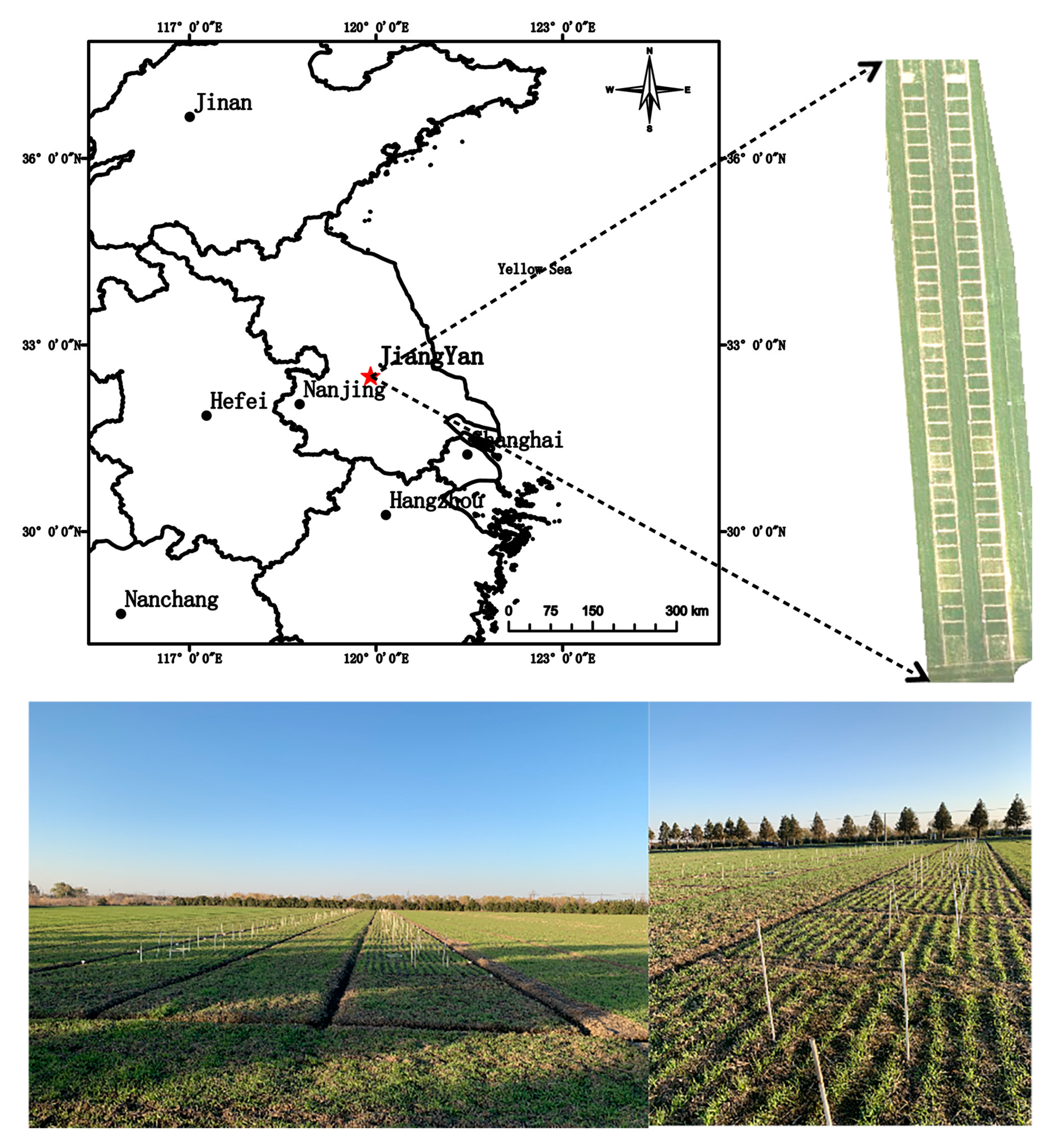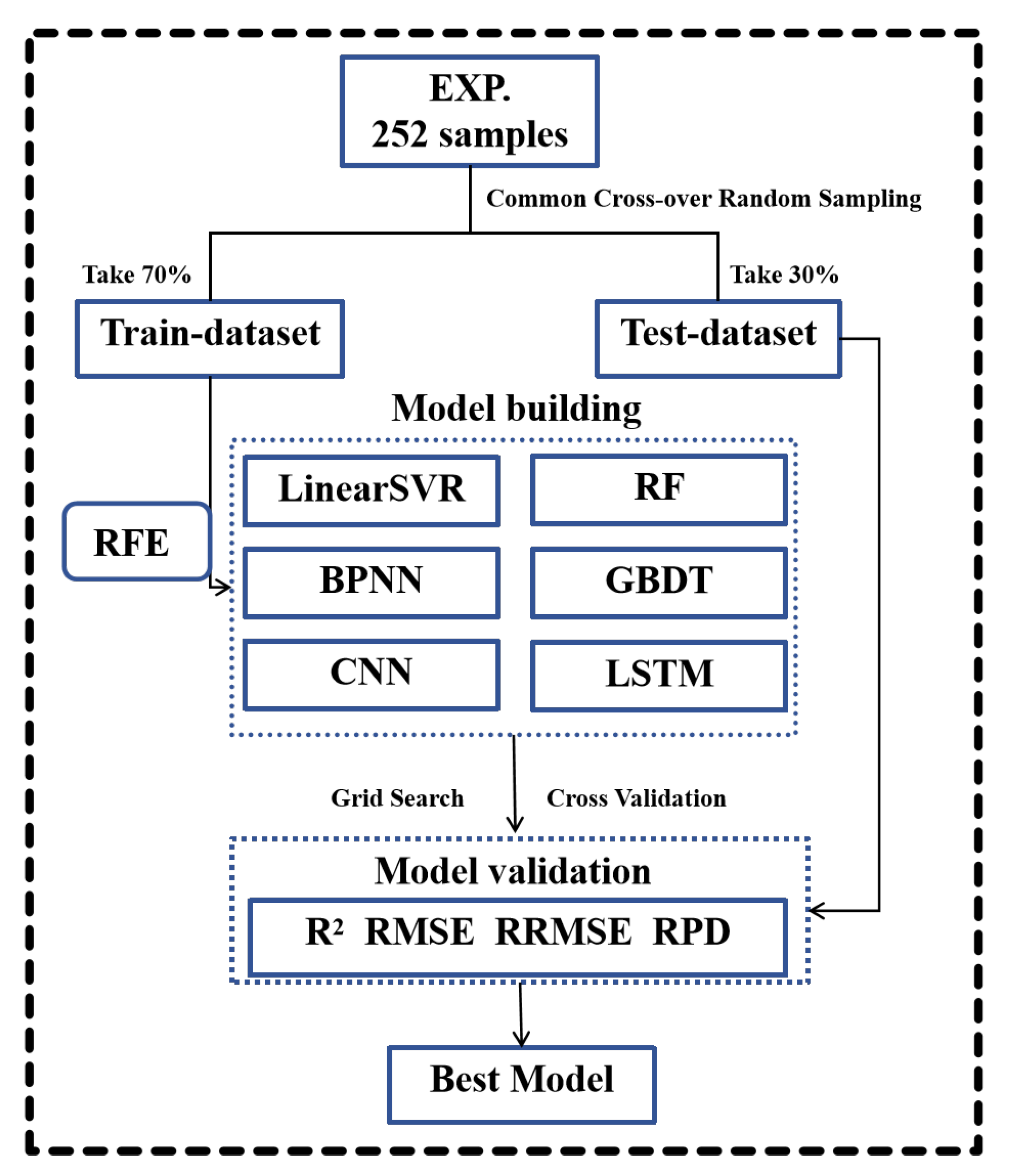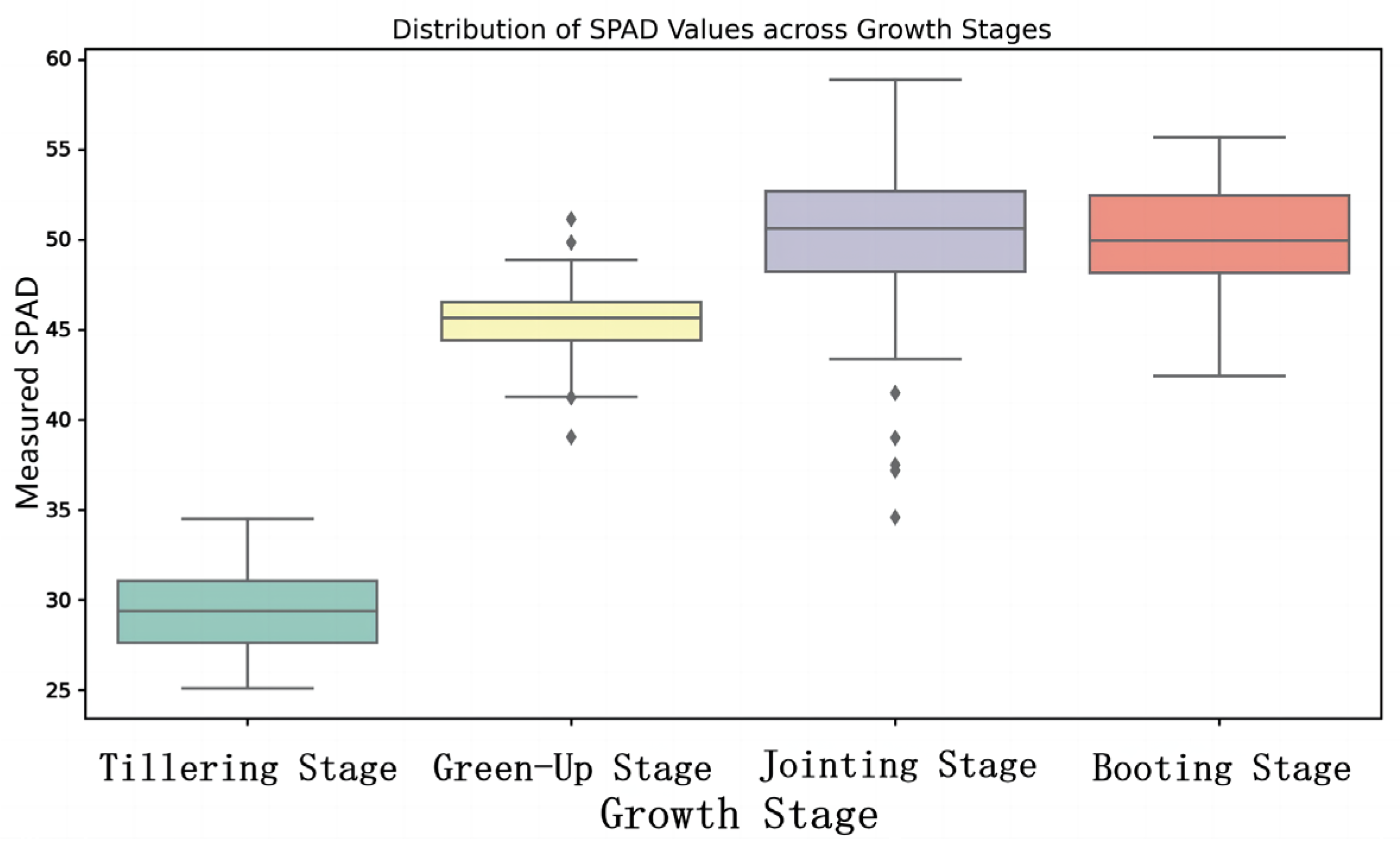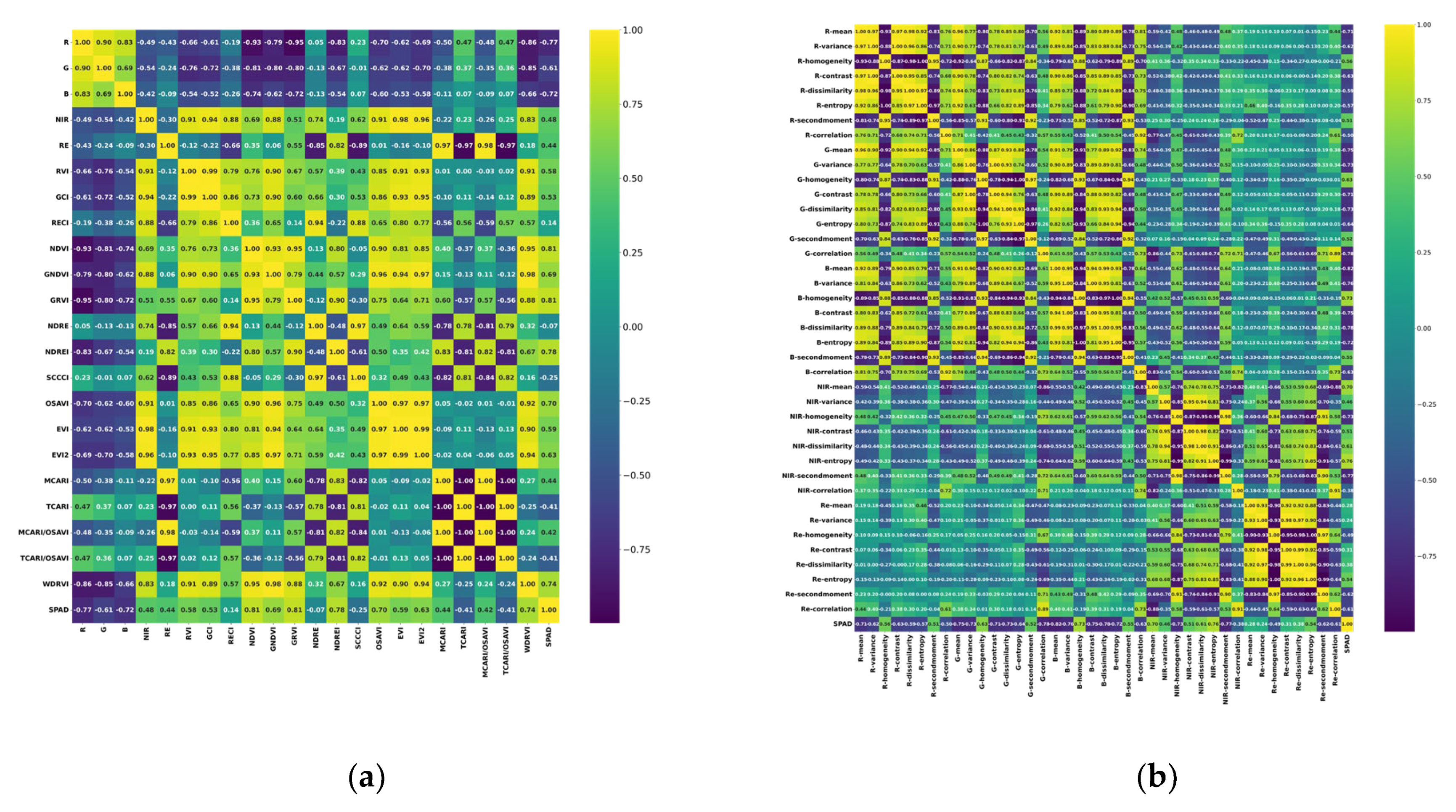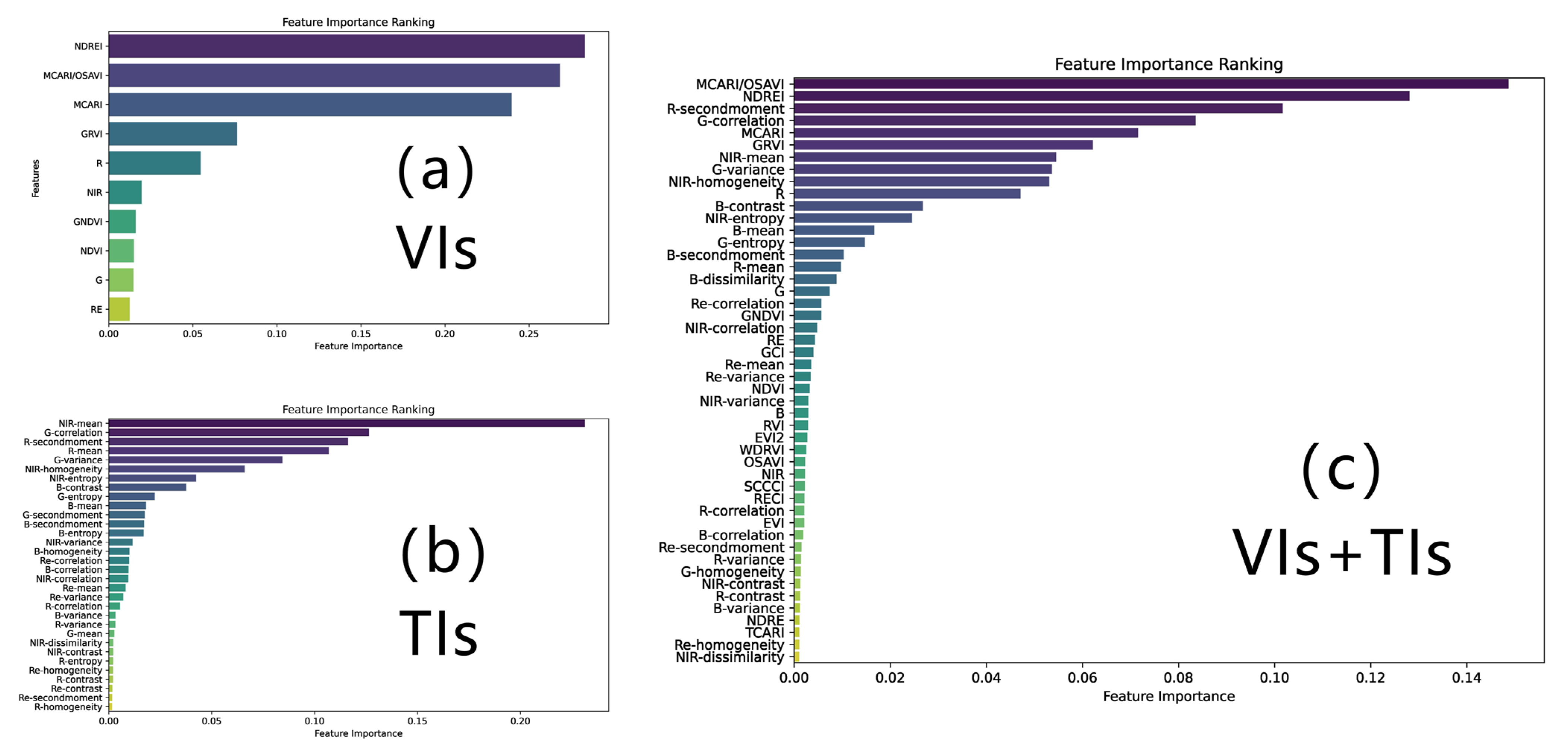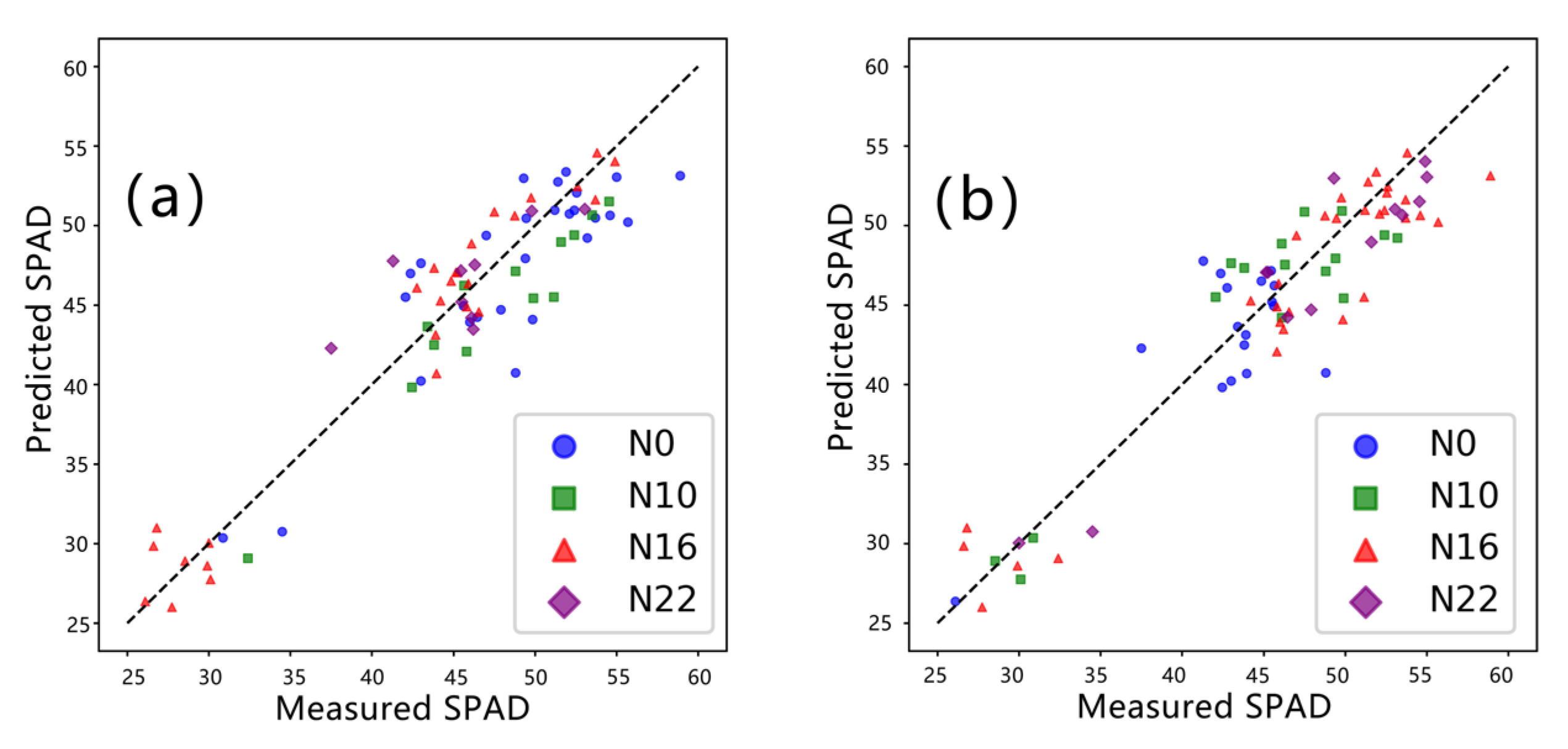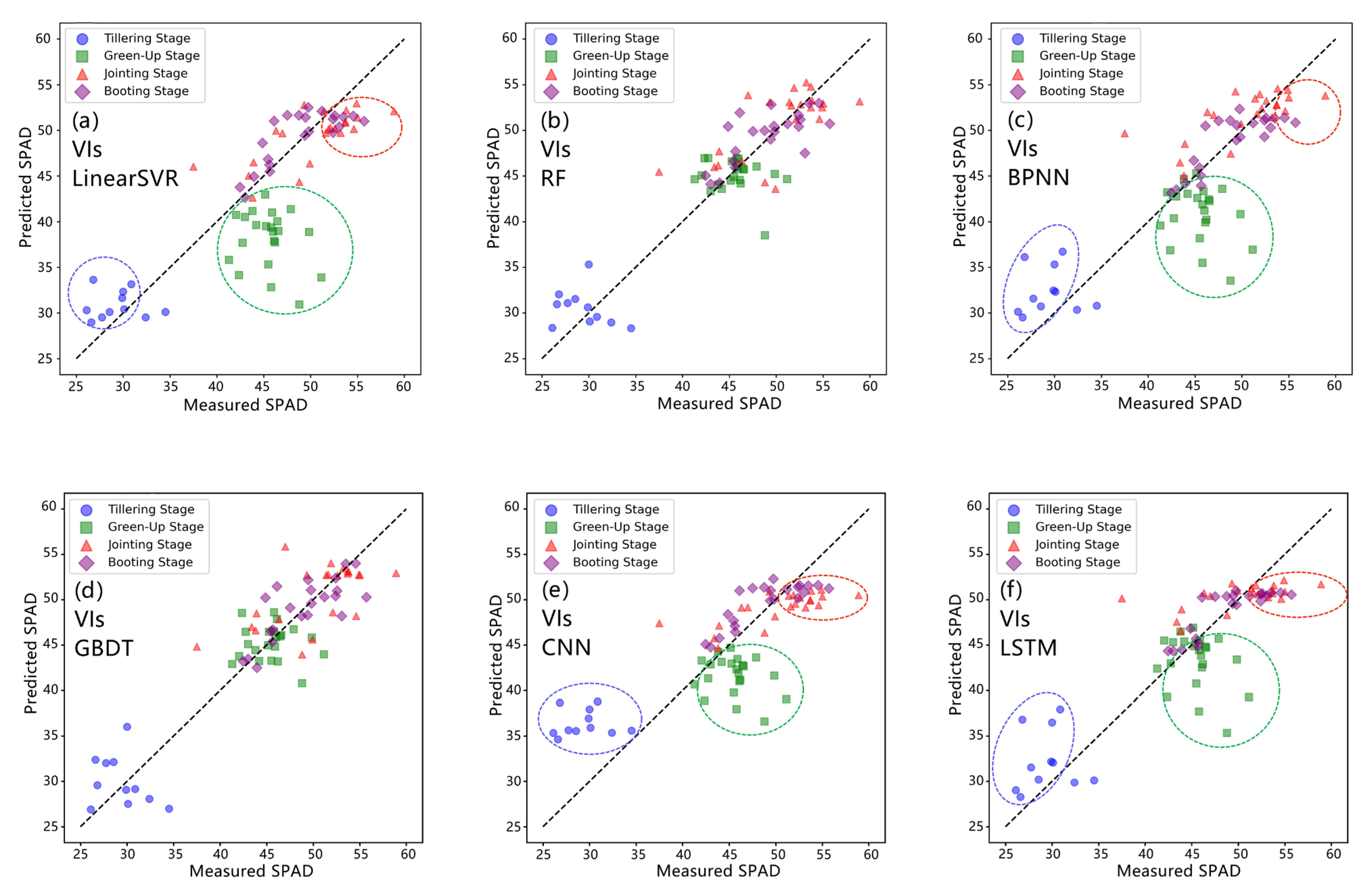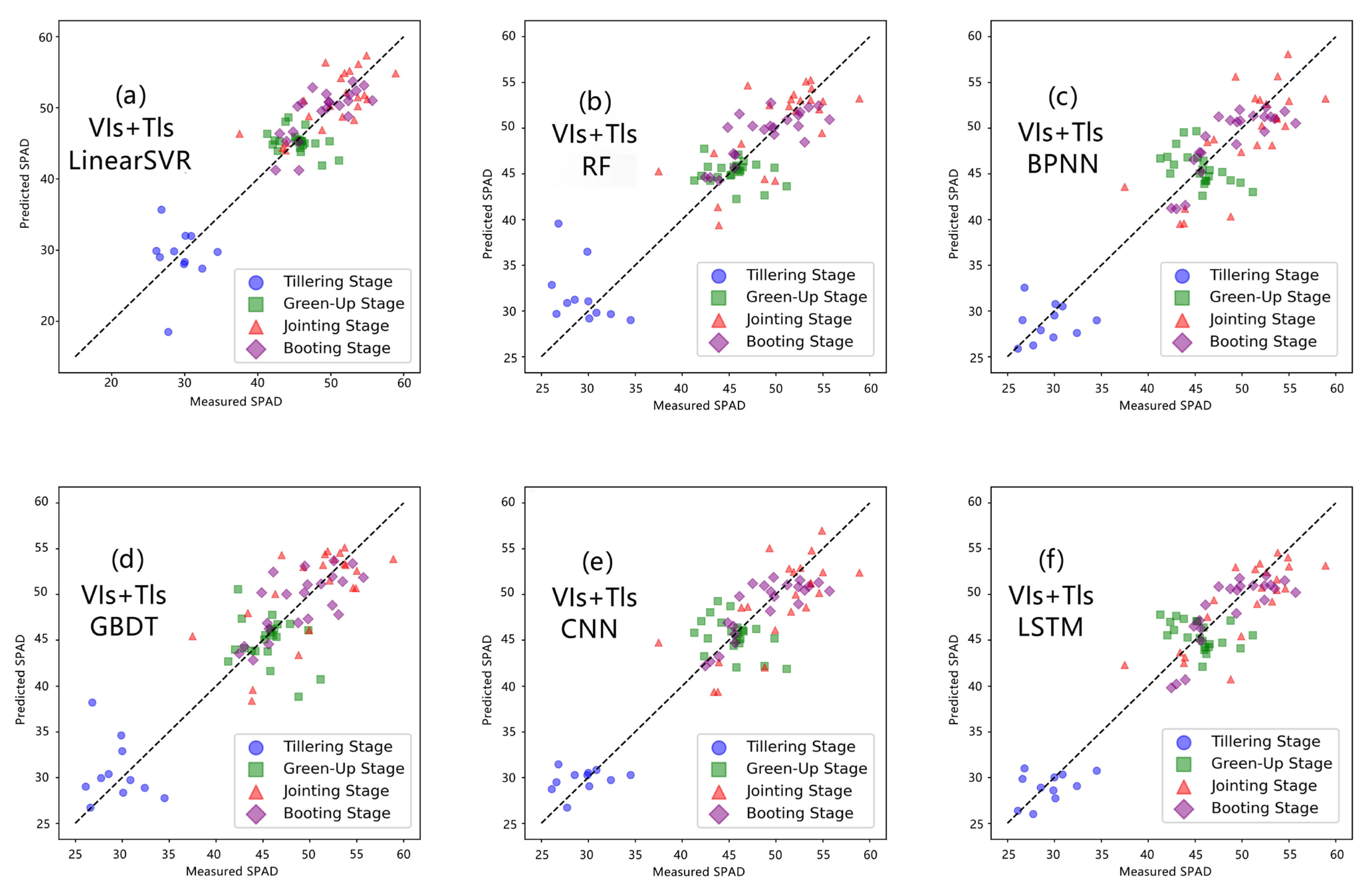1. Introduction
With the increasing frequency of extreme weather events, the vulnerability of winter wheat to low-temperature stress in the Yangtze River’s middle and lower reaches has become an unavoidable challenge in production. Against this backdrop, to breed crops capable of withstanding environmental stress, it becomes imperative to consider the entire growth process of winter wheat through its susceptibility to low-temperature stress during key developmental stages, including tillering, green-up, jointing, and booting stages [
1].
During the winter tillering stage, the invasion of northern cold air outbreaks leads to low-temperature freezing damage, affecting stem internodes’ elongation, and resulting in phenomena such as shortened internodes and reduced plant height [
2]. Long-standing low-temperature frozen damage has been a significant obstacle to the growth and development of winter wheat during the tillering stage [
3]. Even more critical is the occurrence of “late spring frost” events (spring freezing damage) during the crucial period for winter wheat growth in the Yangtze River’s middle and lower reaches: the green-up—jointing—booting period (mid-February to mid-April) [
4]. Data reveal that from 1961 to 2015, Jiangsu Province experienced an average of 3.8 late spring frost events each year, with an average duration of 3.2 days and a high occurrence rate of moderate-to-severe late spring frost events reaching 22% [
5]. As winter wheat transitions from the green-up to the jointing stage, completing the vernalization and photoperiod phases, temperatures gradually rise, and the plant enters a rapid growth and development stage. However, its cold resistance is relatively weak [
6,
7]. Low temperatures during the booting stage could even affect pollen fertility, increase the number of degenerated spikelets and florets, and consequently reduce the number of grains per spike [
8]. During late spring frost events, especially following a sharp temperature drop, external morphological and internal structural damage or even death of crops can occur, resulting in a 10% to 20% reduction in winter wheat yield. In exceptional years, this reduction could reach 30% to 40% or even more [
9,
10].
Therefore, timely and accurate monitoring of the critical developmental stages of winter wheat susceptible to low-temperature stress (including tillering, green-up, jointing, and booting stages) holds the potential to provide substantial support for the selection of cold-resistant varieties, enabling them to better adapt to harsh low-temperature environments [
11]. Furthermore, to cultivate robust seedlings, precise acquisition of growth information will aid in fostering more resilient plants, enhancing their capacity to withstand low-temperature stress [
12]. It’s worth emphasizing that, in the event of low-temperature stress, implementing appropriate supplemental fertilization measures can assist crops in recovering growth promptly, effectively mitigating the adverse impact on crop growth and yield [
13].
The chlorophyll content is a crucial indicator reflecting a crop’s stress resistance and growth status. Under low-temperature stress, the synthesis rate of chlorophyll may be limited, resulting in reduced chlorophyll content in leaves [
14,
15]. Simultaneously, a close correlation exists between chlorophyll concentration and nitrogen content within leaves [
16]. The crop’s nitrogen requirements change throughout the stages from tillering to booting in wheat. With the supply and consumption of nitrogen, there are corresponding shifts in leaf color and nutritional status [
17]. Understanding the dynamic changes in chlorophyll content can aid in determining the optimal timing for nitrogen fertilizer application, thereby sustaining average plant growth and development. This insight provides a valuable reference for mitigating the damage caused by low-temperature stress.
The SPAD-502 m (Minolta Camera Co., Osaka, Japan) measures leaf transmittance of 650 nm red light (chlorophyll absorption) and 940 nm near-infrared light (to correct for leaf thickness), with the ratio of these two transmission values referred to as the SPAD value [
18]. Its SPAD readings provide a non-destructive estimation of leaf chlorophyll content in crops and have been widely used to assess plant photosynthesis and growth status [
19,
20,
21]. Numerous studies have demonstrated that applying the SPAD chlorophyll meter can rapidly determine the relative chlorophyll content in wheat leaves, facilitating the diagnosis of the crop’s nitrogen nutritional status and nitrogen fertilizer management [
22]. Compared to traditional management approaches, wheat nitrogen application has been reduced by approximately 18.8%, increasing wheat yield and nitrogen use efficiency [
23,
24]. Typically, SPAD value measurements are taken on the first fully expanded leaf or flag leaves at different developmental stages. During the growth stages of wheat nutrition, SPAD values provide valuable information about the crop’s nutritional status and allow for supplementary nitrogen application if necessary. During the booting stage of wheat, SPAD values offer the most accurate yield prediction [
25].
However, the use of handheld SPAD-502 m struggles to meet the demands of large-scale wheat growth monitoring. In recent years, non-destructive detection techniques primarily centered around acquiring multispectral images from unmanned aerial vehicles (UAVs) have been widely applied in research concerning wheat leaf chlorophyll content and distribution. Wu et al. [
26] employed a multispectral UAV to capture images of wheat at distinct nitrogen application levels, spanning 7, 14, 21, and 28 days post-heading. Their study involved the development of 26 multispectral Vegetation Indices (VIs) and the application of four machine learning algorithms: Deep Neural Network (DNN), Partial Least Squares (PLS), Random Forest (RF), and Adaptive Boosting (Ada). These algorithms were harnessed to construct models for estimating SPAD values corresponding to various post-heading time points. The findings highlighted the PLS model as the most adept in forecasting wheat SPAD values specifically 14 days after heading. Wang et al. [
27] used UAVs to obtain multispectral images of winter wheat at three key growth stages (heading, flowering, and grain filling) under two water treatments (regular irrigation and drought stress). They selected optimal VIs and nine machine learning algorithms (Cross-Validated Ridge Regression, Ridge Regression, Ada, Bagging Regressor, K-Neighbor, Gradient Boosting Regressor, RF, Support Vector Machine (SVM), and Lasso) to build chlorophyll content estimation models for the three growth stages under the two water treatments. The results indicated that the prediction models for chlorophyll content exhibited high accuracy under different water treatment conditions. The highest prediction accuracy under regular irrigation occurred during the heading stage using the Ridge Regression Cross-Validation model (
R2 = 0.63,
RMSE = 3.28,
NRMSE = 16.2%).
However, the extraction of spectral features often encounters highly complex challenges. To overcome the influence of linear and nonlinear imaging conditions, Wang et al. [
28] proposed Spectral Correlation based on Spatial Correlation (SSC-SRM) utilizing more accurate spectral characteristics. They employed a Mixed Space Attraction Model (MSAM) based on linear Euclidean distance to obtain spatial correlations. Additionally, a spectral correlation based on nonlinear Kullback–Leibler distance (KLD) was introduced. Combining spatial and spectral correlations to mitigate the effects of both linear and nonlinear imaging conditions resulted in improved mapping outcomes. The spectral characteristics utilized were directly extracted from spectral images, thus avoiding spectral unmixing errors. Results demonstrated that SSC-SRM outperforms existing methods. Shang et al. [
29] aimed to eliminate the impact of uninteresting targets with similar spectral signatures on target detection. They developed a novel method called Target-Constrained Interference Minimization Band Selection (TCIMBS) for selecting bands for specific target detection while suppressing unwanted targets and interference sources in the background. The concept was inspired by the Target-Constrained Interference Minimization Filter (TCIMF). By leveraging TCIMF, they derived two Band Priority (BP) criteria, namely Forward Minimum Variance FMinV-BP and Backward Maximum Variance BMaxV-BP, as well as three Band Selection (BS) corresponding criteria, referred to as Sequential Forward TCIMBS (SF-TCIMBS), Sequential Backward TCIMBS (SB-TCIMBS), and Improved SB-TCIMBS (SB-TCIMBS*). Experimental results demonstrated that TCIMBS can enhance detection accuracy and achieve superior performance compared to existing methods.
To our best knowledge, when it comes to remote sensing monitoring of wheat chlorophyll content, many researchers have predominantly focused on studying sample data from individual growth stages, lacking generality across multiple growth stages [
30]. The primary issue with VIs calculated from spectral measurements in the red and near-infrared bands is the saturation that occurs when vegetation coverage is high [
31,
32,
33]. Another concern is that they often lose sensitivity during the reproductive growth stage [
34], making it inadequate to rely solely on spectral characteristics to accurately estimate crop parameters for wheat across multiple growth stages [
35]. The same crop, but with different varieties or varying nitrogen management approaches, significantly impacts agricultural remote sensing models [
36,
37]. This complexity makes it challenging to establish a single crop parameter estimation model effective across multiple growth periods.
Previous research has indeed discovered that variations in crop nutrient content lead to different chlorophyll levels, resulting in significant color changes in wheat leaves and influencing alterations in crop morphological structures [
38]. Texture Indices (TIs) extracted from remote sensing imagery, based on spatial variations in pixel intensities within the image, can emphasize crop canopies’ structure and geometric characteristics [
39]. This approach can partly address the saturation issue when estimating crop growth parameters using VIs and counteract the sensitivity loss during the reproductive growth stage [
33,
40]. While spectral features cannot describe the overall spatial distribution of chlorophyll, relying solely on image texture features cannot accurately reflect internal chlorophyll content [
41]. The combined use of spectral and texture information from multispectral imagery can enhance the reliability and accuracy of results [
42,
43]. Guo et al. [
44] extracted common spectral VIs and TIs from multispectral UAV images and employed a stepwise regression model to select the optimal combination of spectral and TIs for predicting SPAD values of maize at different growth stages. The results demonstrated a strong correlation between VIs and TIs with SPAD values. Furthermore, combining VIs and TIs improved the accuracy of predicting SPAD values of maize.
Due to substantial differences in plant structure, leaf size, morphology, arrangement, and plant density between wheat and maize, wheat’s texture features differ significantly from those of maize [
45]. However, the role of texture features in estimating wheat SPAD values still requires further exploration.
In summary, this study hypothesizes that in the winter wheat region of the Yangtze River’s middle and lower reaches, integrating VIs and TIs from multispectral UAV imagery can enable the accurate monitoring of winter wheat’s SPAD values. This approach establishes SPAD value estimation models applicable across multiple key growth and developmental stages (tillering, green-up, jointing, and booting stages), various wheat varieties, and different nitrogen management approaches. Such models can assist in promptly adjusting agricultural management measures, thereby mitigating the damage caused by extreme weather events like late spring frost and alleviating the impact of low-temperature stress on winter wheat growth and yield.
To validate this hypothesis, the study focuses on winter wheat, collecting multispectral UAV imagery and actual SPAD measurements during the tillering, green-up, jointing, and booting stages. Extracted and constructed VIs, TIs, and a fusion of VIs and TIs are subjected to machine learning algorithms. The study aims to construct and determine the optimal SPAD value estimation models suitable for multiple growth stages of winter wheat, various wheat varieties, and different nitrogen management approaches.
4. Discussion
This study involves wheat nitrogen management experiments with four winter wheat varieties and four nitrogen application rates. Consequently, establishing the relationship between winter wheat canopy SPAD values and remote sensing variables became a complex task, posing substantial challenges in model development. The objective was to formulate a dynamic estimation model for winter wheat canopy SPAD values, customized for various cultivars and nitrogen application strategies. This model aimed to address challenges during vulnerable growth stages exposed to low-temperature stress, namely tillering, green-up, jointing, and booting. Leveraging UAV-based multispectral imagery, this research encompassed the extraction and construction of both VIs and TIs. Pearson correlation analysis was conducted between these variables and the measured SPAD values of winter wheat. Subsequently, Recursive Feature Elimination (RFE) was employed to select optimal subsets of VIs, TIs, and their fused combinations. These selected remote sensing variables were integrated into six machine learning algorithms, namely LinearSVR, RF, BPNN, GBDT, CNN, and LSTM. The goal was to establish winter wheat SPAD value estimation models. The models were then evaluated based on various performance metrics, culminating in identifying the optimal inversion model, which was further subjected to validation. The comprehensive methodology employed in this study addresses the complex and multifaceted nature of winter wheat SPAD value estimation. By integrating various approaches, from remote sensing to machine learning, the study demonstrates a systematic process for building reliable SPAD value estimation models capable of accommodating diverse cultivars and nitrogen application strategies. The findings provide valuable insights into optimizing agricultural management practices and enhancing winter wheat growth and yield outcomes.
4.1. Contribution of Different Remote Sensing Variables to Winter Wheat SPAD Value Prediction
4.1.1. Performance of Models Based on VIs
In the models established based on VIs, the performance of SPAD value estimation was assessed by comparing the estimated SPAD values obtained from each regression model with the corresponding measured values through scatter plots (
Figure 9). As indicated by the data points covered by red circles, it is noteworthy that most regression methods underestimated the SPAD values during the jointing and booting stages of winter wheat. These underestimated data points often represent areas where winter wheat had higher density and canopy height. This phenomenon could be attributed to common saturation issues in optical remote sensing, particularly in moderate to high vegetation cover and yield [
75,
76,
77].
Furthermore, as evident from the data points covered by green circles, LinearSVR, BPNN, CNN, and LSTM underestimated the SPAD values during the green-up stage of winter wheat for most cases. This might be because the green-up stage marks the beginning of winter wheat growth in the subsequent year, following an extended dormancy period during the winter. The wheat plants deplete their nutrient reserves over this dormant period and require nutrient replenishment for subsequent growth and energy accumulation [
75]. Consequently, there is significant variability in chlorophyll content across different varieties and nitrogen management strategies, rendering the relationship between winter wheat canopy SPAD values and VIs complex. Due to these intricate dynamics, machine learning models struggle to achieve perfect SPAD value estimation.
In the scatter plots, data points corresponding to the tillering stage of winter wheat, covered by blue circles, were often overestimated by most regression models. This could potentially be attributed to the fact that during the tillering stage, the vegetation cover of winter wheat is relatively low, with a significant amount of exposed soil, which can lead to an overestimation of SPAD values [
78].
Compared to LinearSVR, CNN, and BPNN, the underestimation of SPAD values during the green-up stage is somewhat alleviated in LSTM and GBDT, and RF achieves the best estimation performance for this stage. Additionally, the underestimation of SPAD values during the jointing and booting stages, as well as the overestimation of SPAD values during the tillering stage, is also best captured by RF and GBDT. RF is relatively less influenced by light saturation compared to the other machine learning models. This observation somewhat implies its capability to manage peak information effectively [
79]. Therefore, RF achieves the best winter wheat SPAD value estimation based on VIs, consistent with previous research findings [
65,
80].
4.1.2. Performance of Regression Models Based on TIs
Through Pearson correlation analysis, we found that the texture index “Mean” extracted using GLCM exhibited good correlations with SPAD values across different bands. This aligns with the conclusions of Zheng et al. [
81], who concluded that “mean” was the best TI for estimating rice biomass using various TIs. By integrating the “mean” texture index as an input, the accuracy and stability of the estimation model can be elevated, offering valuable insights for refining future methodologies and advancing wheat chlorophyll content estimation models.
In the construction of SPAD value estimation models, models based on TIs outperformed those based on VIs, indicating the substantial potential of TIs in predicting SPAD values. This finding aligns with Guo et al.’s research [
44], which used multispectral images from UAVs to predict corn SPAD values by combining VIs and TIs. In comparison to VIs, TIs exhibited a stronger correlation with SPAD values.
However, in a study by Maitiniyazi et al. [
77] involving the prediction of soybean yield through the fusion of multimodal data and deep learning from UAVs, it was shown that spectral information performed better in predicting soybean yield during the early growth stage of a single growth period, using images captured by UAVs. This study extracted various remote sensing variables, including TIs and Vis, for yield estimation. The results suggested that spectral information was superior to texture features in predicting soybean yield, indicating that texture features could be a potential alternative to VIs with reasonably good predictive accuracy. In contrast, texture information seemed to estimate physiological parameters during various growth stages of crops more effectively. This difference in findings could be attributed to several factors. On the one hand, there exists a strong correlation between chlorophyll content and plant photosynthesis. Plants with higher chlorophyll content exhibit elevated photosynthetic capacity and tend to accumulate a greater amount of photosynthetic products. Winter wheat with higher chlorophyll content often has larger leaves during the early growth stages [
27]. As a result, remote sensing images display noticeable variations in texture among winter wheat samples with distinct SPAD values. Furthermore, our study involved different growth stages, various nitrogen management strategies, and four different winter wheat varieties, which contributed to more pronounced texture differences.
On the other hand, after RFE feature selection, all extracted TIs retained a significant number of features for subsequent modeling, whereas VIs retained only a small subset of features. This suggests that the unscreened VIs might have severe linear correlations and data redundancy between them [
80]. The combination of these factors led to the better performance of models based on TIs in constructing SPAD value estimation models for winter wheat pre-heading stages.
4.1.3. Performance of Regression Models Based on Fusion of VIs and TIs
Consistent with our hypothesis, the overall trend of estimation accuracy among the six algorithms using different parameter combinations for modeling is as follows: fusion of VIs and TIs model > TIs model > VIs model. VIs provide the spectral information of winter wheat canopy, while TIs contribute spatial structural information. By fusing VIs and TIs, relevant information regarding winter wheat canopy SPAD values can be extracted from varying perspectives to enhance the accuracy of the model. This finding is congruent with the research by Zheng et al. [
81], who improved the estimation of above-ground biomass in rice using a combination of UAV images, TIs, and VIs, as well as the results of Guo et al. [
82], who integrated spectral and texture information for monitoring pear tree growth status using UAV remote sensing. Regardless of the modeling method used, multimodal data fusion consistently provides superior performance for the estimation model of winter wheat pre-heading stage SPAD values.
In establishing the SPAD value estimation model using the fusion of VIs and TIs, scatter plots were used to compare the estimated SPAD values obtained by each regression method with the corresponding measured values (
Figure 10). It is worth noting that all regression methods considerably corrected the issues of underestimation and overestimation of winter wheat SPAD values observed in the model based solely on VIs. Fusing VIs and TIs could alleviate the saturation problem when using spectral information to estimate crop growth parameters. This can be attributed to the heterogeneity in VIs and TIs, which aligns with previous research findings [
33,
40].
Discrete data points during the tillering and green-up stages also showed significant improvement and the fitting effect between predicted and measured values was enhanced. By fusing multiple features, the model becomes adept at extracting pertinent information from diverse sources, which in turn diminishes the impact of noise and enhances the overall accuracy of chlorophyll content estimation [
83].
4.2. Performance of the Optimal Estimation Model
The deep-learning-based estimation model LSTM fuses VIs and TIs and demonstrates remarkable performance in predicting winter wheat pre-heading stage SPAD values. According to Rossel et al. [
74], LSTM achieved an
RPD greater than 2.5 on the validation set in this study, indicating excellent estimation of winter wheat SPAD values. Furthermore, LSTM achieved the highest
R2 among all regression models and the lowest
RMSE and
RRMSE values. This implies that the model can effectively explain the variability of the target variable with minimal differences between predicted and actual winter wheat SPAD values. Hence, it stands as the optimal model for estimating SPAD values during the pre-heading stage of winter wheat. This observation aligns with the conclusions drawn by Liu et al. [
78], who used UAV imagery and shallow and deep machine learning algorithms to estimate leaf area index. Their research indicated that deep machine learning models combined with multimodal data fusion could provide more accurate and reliable crop parameter estimation.
As shown in the inversion results (
Figure 8), we tested the selected optimal model LSTM (fusing VIs and TIs) on the test dataset by different wheat varieties and nitrogen application levels. Among different wheat varieties (
Table 6), NM 26 and YM 22 showed slightly poorer inversion results. Similarly, among different nitrogen levels (
Table 7), N 0 exhibited slightly lower inversion results. However, most other varieties and nitrogen levels exhibited good inversion results. Both NM 26 and YM 22 are nitrogen-inefficient varieties. The considerable variation in chlorophyll content for these nitrogen-inefficient varieties, especially under lower nitrogen levels [
84], presents a challenging task for the model due to the complexity of the relationship between canopy information and SPAD values.
In summary, as depicted in
Figure 8 and
Table 6 and
Table 7, the newly constructed optimal regression model based on VIs and TIs, selected through RFE feature selection and established using LSTM, demonstrates good applicability and generalization across various winter wheat varieties and nitrogen management strategies. LSTM’s weight adjustments through backpropagation mitigate overfitting issues and enhance the model’s generalization ability [
85]. This is particularly advantageous when dealing with datasets like winter wheat growth, where there may be noise or fluctuations in the data. The LSTM’s capacity to learn from errors and fine-tune its parameters ensures that it can effectively capture the underlying patterns without being overly influenced by noise. Additionally, LSTM excels in capturing long-term dependencies in the data, which is a critical factor in modeling winter wheat growth [
86,
87]. During the various growth stages of winter wheat, the condition of the crop may be influenced by multiple preceding periods. Furthermore, the complex nonlinear mapping relationships between the input features (such as VIs and TIs) and the target variable (SPAD values) are effectively handled by LSTM. This is essential because plant growth is a multifaceted process influenced by numerous interrelated variables.
The LSTM’s capacity to learn and model these intricate relationships aids in interpreting the nuanced and often nonlinear connections between the various factors and the growth of winter wheat. This makes it a powerful tool for accurately estimating SPAD values and, by extension, assessing the crop’s health and resilience during the pre-heading growth stage.
4.3. Limitations and Future Directions
While our research has achieved encouraging results in estimating winter wheat SPAD values, there are certain limitations that need to be addressed. Our models primarily focus on the pre-heading stages of winter wheat growth, leaving gaps in modeling the entire growth cycle, including the heading stage. This could impact the accuracy of our models when predicting crop parameters throughout the complete growth period.
To overcome these limitations and achieve greater advancements, our future efforts will be directed toward establishing models applicable to the entire growth cycle of winter wheat, encompassing not only the pre-heading but also the post-heading stages. This endeavor would necessitate considering the influence of different growth phases on SPAD values. It may require incorporating additional features and data sources, such as ground-level observations and meteorological data. Such enhancements would contribute to the overall comprehensiveness and precision of the models, providing a more holistic understanding of winter wheat growth dynamics and enabling more accurate parameter estimation throughout the entire growth cycle.
5. Conclusions
The findings of this study demonstrate that integrating VIs and TIs from UAV-based multispectral imagery allows for more accurate monitoring of winter wheat SPAD values in the middle and lower reaches of the Yangtze River region. This approach enables the construction of SPAD value estimation models that apply to various crucial growth stages before heading (tillering, green-up, jointing, and booting), multiple cultivars, and different nitrogen management strategies. Overall, the estimation accuracy follows the order of the fused VIs and TIs model, TIs model, and VIs model.
The model established based on VIs for predicting winter wheat pre-heading canopy SPAD values exhibits both overestimation and underestimation issues. Underestimation occurs under high vegetation cover conditions due to spectral saturation, while periods with more exposed soil tend to overestimate SPAD values. Additionally, accurate SPAD value estimation during the regrowth phase of the second-year winter wheat, known as the “green-up” stage, proves challenging.
Models based on TIs outperform those based on VIs, showcasing substantial potential in SPAD value prediction. The texture index “Mean”, extracted using the GLCM method, exhibits a good correlation with SPAD values across various wavelength bands. Compared to VIs, TIs exhibit a closer association with SPAD values, offering a potential alternative to spectral variables with considerable predictive accuracy.
The newly constructed optimal regression model integrates fused spectral and TIs through RFE feature selection and utilizes LSTM, demonstrating good applicability and generalization across different winter wheat cultivars and nitrogen management strategies. This model accurately estimates pre-heading canopy SPAD values. Feature fusion leads to the model’s capability to extract pertinent information from diverse sources, effectively mitigating the influence of noise and thereby augmenting the overall accuracy of chlorophyll content estimation. Moreover, it significantly corrects the issues of underestimation and overestimation seen in models based solely on VIs.
This research provides valuable insights for farmers to adjust agricultural management practices promptly, thereby mitigating the hazards posed by pre-heading cold damage and improving the growth and yield of winter wheat. Future endeavors will focus on optimizing and enhancing the multi-feature fusion model, introducing the post-heading growth stages of winter wheat, and incorporating additional features to improve further the accuracy and applicability of the SPAD value estimation model. This will facilitate more comprehensive and precise monitoring and assessment of winter wheat growth status.
